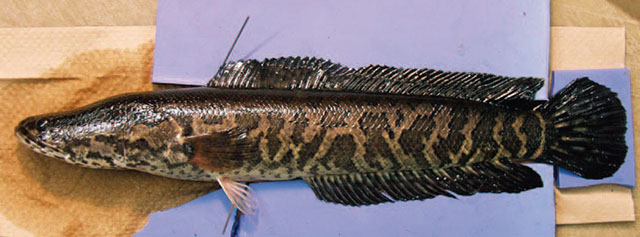 |
| Government of Alberta |
"Prussian carp pose threats to native fish populations by out-competing native species for food and habitat, as well as spreading new diseases and pathogens. They are easily spread from one water body to another, and it is extremely costly and difficult to try and manage, contain and destroy them once they have become established. It is also illegal to move live fish from one water body to another. Penalties for illegally transferring fish can be up to $100,000 and/or a year in prison." Jess Sinclair, spokesperson, Environment and Parks Ministry, Alberta
"This might be a little shocking, but males are not actually needed for reproduction for this species. This is a bit unusual in the fish world. The females can reproduce clonally. They can clone themselves over and over and over again. The females lay the eggs and actually take sperm from another species, so another species will fertilize the eggs but they won't actually contribute any genetic material. This allows them to reproduce in huge numbers. It also means that all the individuals, and we've done some preliminary genetic work, they're all clones. They're all identical to one another." "Goldfish are found throughout the province and people do release them. And we think that's how this little guy got in here and now they're really starting to take over. We think they first came here in 2000 and the reason it took so long to find them is that people misidentified them as goldfish. They first arrived in Medicine Hat and since then, we find them all the way up to the city of Red Deer, and they are literally everywhere." Mark Poesch, researcher, assistant professor, Faculty of Agricultural, Life and Environmental Sciences, University of Alberta
 |
| Non-native Prussian carp, which are closely related to goldfish, are being found in “significant” numbers in the Red Deer River and its tributaries. (Contributed photo). |
Yet another invasive species causing consternation in Canada. This time it's another fish. Not as gruesome as the snakehead, but doing its best to give conservationist, environmentalists and the governments of Alberta and Saskatchewan a headache. "Catch it, kill it", a notice on the Alberta government website urges. "If you catch Prussian carp while angling, please kill it and either take it home to eat or properly dispose of it in the garbage."
It is edible; a relative of the species goldfish, it can weigh up to three kilograms at full maturity, and it presents an existential danger to native fish due to its amazingly rapid reproduction, meaning that the food sources for fish undergo a highly competitive race for survival. In sheer numbers this invasive carp is capable of out-fishing native species.
 |
| Northern snakehead. Photo: U.S. Geological Survey |
Like the snakehead fish that has proven to be a concern for the Great Lakes, and which can be found throughout large swaths of the United States, gradually moving into Canada, these fish out-compete native species for habitat and for a finite food supply. The Prussian cap has been seen n Alberta since 2015, but how it entered the province's waterways is not known. And it is able to survive on land, searching out new habitat "for relatively long periods of time".
A government fact sheet dating from 2015, updated in 2018, points out that "Many invasive carp were imported as pond or aquarium species of sold in Asian food markets". Some obviously found their way into waterways at the hands of people who released them there. And the rest is, as one says, history. "It's a little freaky. They're very opportunistic fish. We believe humans are also picking them up and moving them around", commented Nicole Kimmel, invasive species expert with the Alberta government.
Invasive species become a real existential danger to native species; boring insects from abroad threaten tree species in Canada, fungi, aquatic creatures and vegetation that reproduce exponentially, taking the place of native species. What invasive species mostly have in common aside from their threat to native species is that, removed from their home territory, they thrive because they have been geographically separated from the presence of other organisms that normally keep them in control.
Wild boar have become a problem in the Prairie Provinces; they're habitat destructive, difficult to control. A variety of invaders such as bloodsucking sea lampreys have established themselves in Lake Erie. The alarm has been sounded on some species known to inhabit waterways in Ontario, such as the Weis Catfish one of the largest freshwater species, named The European Maneater, on the "prohibited" list.
British Columbia enacts fines of up to $250,000 for anyone caught releasing snakeheads, nicknamed Frankenfish, able to grow to a metre in length and to move overland in search of new waterways to establish themselves in. The Central Park Lagoon in Burnaby was drained when a snakehead was spotted in it, to be able to catch and kill it, in 2012.
 |
Labels: Canada, Habitat, Invasive Species

0 Comments:
Post a Comment
<< Home